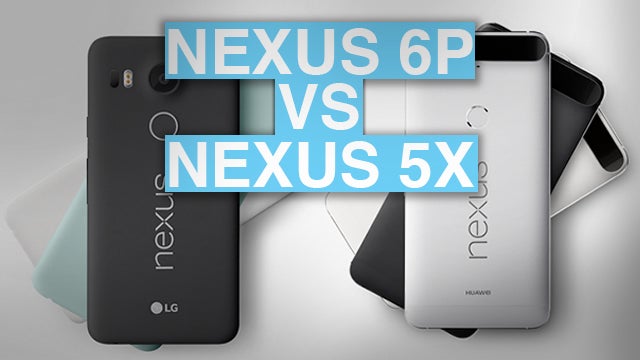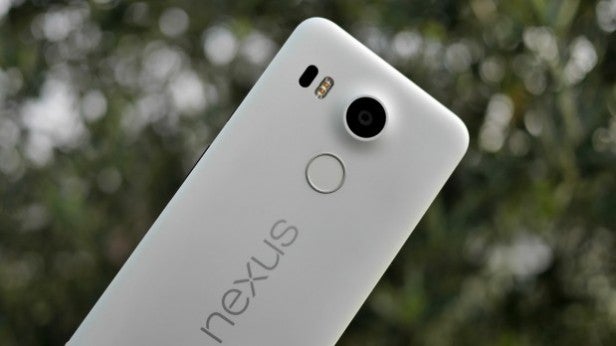Nexus 6P vs Nexus 5X: What’s the difference?

Which Nexus is best? Do you go Nexus 5X or Nexus 6P? We look at how the two Google smartphones match up.
For the first time ever, Google launched two new Android flagship phones simultaneously in the Nexus 5X and the Nexus 6P. Despite sharing a name and an operating system, it might surprise you how different these two phones are.
So, apart from the obvious size differences, how do the two compare?
Watch our Nexus 5X hands-on video
Nexus 5X vs Nexus 6P: Design
Nexus 5X: Soft touch plastic body, 7.9mm thick, 136g, fingerprint sensor, USB Type-C
Nexus 6P: All-aluminium body with chamfered edges, 7.3mm thick, 178g, fingerprint sensor, USB Type-C
Google has diverged from the Nexus 6 with both the Nexus 6P and the Nexus 5X, but in very different ways. The Nexus 5X goes back to the design principles of the Nexus 5, while the Nexus 6P represents a step into the future.
In the LG-made Nexus 5X’s case, that means a comfortable and unassuming soft touch plastic body. It’s not flashy, and it runs somewhat counter to the ‘metal or die’ philosophy of modern flagship phone design, but we like it.
The Nexus 5X sits nicely in the hand, with a just-right display size (more on which in a moment) and a just-right 136g weight. It’s half-a-centimetre thicker than the Nexus 6P at 7.9mm, but that’s the only way in which it’s bigger.
As for the Huawei-made Nexus 6P, it’s a giant premium slab of a smartphone, every inch the Android flagship.
Its all-metal design, flat sides and chamfered edges give it a look and feel of class that’s up there with the Samsung Galaxy S6 and iPhone 6S. You won’t be slinging it around single-handed in a hurry – it’s both too tall and too wide for such discrete operation, and at 178g it’s a staggering 42g heavier than the plastic Nexus 5X.
But the Nexus 6P isn’t setting out to disappear in either your pocket or your hands. It’s been designed to stand out and impress, and it does just that.
The two phones aren’t completely unalike, however. Both have the same fingerprint sensors positioned two thirds of the way up the back, providing security and quick unlock access to the Android OS.
Both phones have also ditched microUSB in favour of USB Type-C – a fast, flexible, compact new connection and charging standard that also allows for reversible plugs.
Watch our Nexus 6P hands-on video
Nexus 5X vs Nexus 6P: Screen
Nexus 5X: 5.2-inch IPS LCD, 1920 x 1080, 423ppi
Nexus 6P: 5.7-inch AMOLED, 2560 x 1440, 518ppi
The Nexus 5X is packing a 5.2-inch screen, which these days is considered a mid-sized display. It’s certainly small enough to use single-handed, provided you have fairly long fingers.
The Nexus 6P, by contrast, features a 5.7-inch display. It’s a phablet in the vein of the Samsung Galaxy Note 5, and is more suited to two-handed usage as a result.
Aside from the obvious size difference, it’s resolution that really separates the two handsets in this display department. The Nexus 5X’s is 1080p, which is just fine for a screen of this size. Sure, the Galaxy S6 packs a QHD resolution into a similar-sized screen, but that’s arguably overkill.
The larger 6P’s larger screen is much better suited to such a QHD resolution, where those densely packed pixels can properly stretch their legs on 2K video content and games.
In terms of pixel density, the Nexus 6P packs in almost 100 more per inch than the Nexus 5X, but that’s not what makes the difference in terms of quality. That comes down to the different panel technologies employed.
While the Nexus 5X uses a traditional IPS LCD, the Nexus 6P follows Samsung’s lead (not to mention the Nexus 6) and adopts AMOLED technology. Colours pop much more than on the Nexus 5X as a result, and blacks are much deeper.
Some find AMOLED displays to be oversaturated and even a little garish, favouring vibrancy over accuracy. For such folks, Huawei has included an sRGB display mode that cools the colours down a bit.
It also means that you get an Ambient Display mode with the larger phone, which only lights up some of the screen when you pick it up, providing you with essential information without taking up much power.
The Nexus 6P’s screen is also tougher than the Nexus 5X’s thanks to the presence of Gorilla Glass 4 – the smaller phone usese Gorilla Glass 3.
Both screens are great, but there’s no doubting that the Nexus 6P display is a step or two ahead.
Buy Now: Nexus 6P at Amazon.com from $399.99
Related: Samsung Galaxy S7 vs S6
Nexus 5X vs Nexus 6P: Power
Nexus 5X: 1.8GHz Snapdragon 808 CPU, Adreno 418 GPU, 2GB RAM
Nexus 6P: 2GHz Snapdragon 810 CPU, Adreno 430 GPU, 3GB RAM
It should come as no surprise that the 6P, with its more power-hungry display should require a little more under the hood than the 5X. The Huawei-built handset is going with the 64-bit Snapdragon 810, but not the troublesome one found inside the Xperia Z3. Instead, it’s the 2.1 version that powers the OnePlus 2.
That’s backed up a generous 3GB RAM, which is more than adequate to keep things running along nice and slick.
The 5X is no slouch either, having moved to a Snapdragon 808 processor (the same one that power the LG G4) with a lesser 2GB RAM and a new Adreno 418 GPU. This is another Qualcomm 64-bit chipset that has a very similar attributes to its bigger brother, but which relies on six cores as opposed to the eight cores used in the 810. It also has a slightly slower clock speed.
Ultimately, both are well equipped to run stock Android Marshmallow at full pelt, but the Nexus 6P feels noticeably faster.
In terms of cold-hard figures, we benchmarked the Nexus 5X at 3,543 in the Geekbench multi-core test. The Nexus 6P was a fair bit faster at 4,245, which is especially impressive when you consider that it has a lot more pixels to push around on that QHD display.

Nexus 5X vs Nexus 6P: Camera
Nexus 5X: 12.3MP rear, f/2.0 aperture, 1/2.3-inch sensor, laser autofocus, dual-LED flash, 5MP front
Nexus 6P: 12.3MP rear, f/2.0 aperture, 1/2.3-inch sensor, laser autofocus, dual-LED flash, 8MP front
Previous Nexus phones have suffered when it comes to camera performance, which is why it’s so gratifying to say that both the Nexus 5X and the Nexus 6P deliver the photographic goods.
The two phones share surprisingly little, but one component that appears to be identical on both is the main camera unit. They’re both 12.3-megapixel units, which is less than is usual for a modern Android flagship phone.
That’s because Google has wisely emphasised low-light performance, and the two Nexus phones have maximised this with larger-than-average 1/2.3-inch image sensors. Combined with that lower pixel count, it means that the pixels themselves are significantly larger than normal 1.55 microns.
The result is that more light can be let in, helping image quality and enabling the camera to shoot at faster shutter speeds in lower light (assisted by laser autofocus). That last point is handy, as there’s no OIS in either phone, though it can’t completely make up for the omission.
If you care about high resolution video, the 6P and 5X are capable of filming at a maximum 4K. Both can also capture slow motion footage, though the Nexus 6P does so at 240fps while the Nexus 5X can only manage 120fps.
The biggest difference relates to the front-facing cameras, with the Nexus 6P benefitting from the larger 8-megapixel unit. Meanwhile the Nexus 5X has a 5-megapixel selfie cam.
While both phone cameras operate from a similar base spec, then, the Nexus 6P has a clear edge thanks to several bonus features.
In terms of shooting experience, both benefit from Google’s lean and stripped-back camera UI to help you capture moments quickly and without fiddling. Of course, if you’re the type of mobile photographer that likes to go hands-on with in-depth manual settings, you’re better off with a Galaxy S6 or an LG G4. Or, you know, a proper camera.
All in all, the new Nexus camera experience isn’t right up there with the very best on the market, but it’s not far behind – and that applies to both phones.
Buy Now: Nexus 5X at Amazon.com from $279.99
Related: Android 6.0 Marshmallow features: What’s new?
Nexus 5X vs Nexus 6P: Battery
Nexus 5X: 2700mAh
Nexus 6P: 3450mAh
It’s no surprise to find out that the 5.7-inch Nexus 6P with a more power-sapping QHD display requires a more sizeable battery to keep it powered. Google has opted for a 3,450mAh non-removable battery. The Nexus 5X in comparison is packed with a 2,700mAh battery.
With battery life being another key issue with previous Nexus phones, it’s gratifying to see that these batteries are relatively large. Going big appears to have paid off.
Neither is particularly outstanding, but both phones easily go the day and well into the next with general use.
Fortunately with the presence of USB Type-C both support quick charging technology that grants a full charge in half the time it takes to do the same on the iPhone 6S Plus. You’ll have to ditch your drawer of microUSB cables, though.
Meanwhile, Android Marshmallow’s new Doze feature stretches out the battery performance of both phones when in standby. It works by detecting when the handset is inactive, slowing down or shutting off unnecessary features to reduce power consumption.
It’s taken a long time to get something like this baked into stock Android, but it’s paid off. Leaving the Nexus 5X overnight, we found that it lost just one percent power, while with the Nexus 6P it was just a couple of percent. Pre-Doze Nexus handsets, by contrast, would lose 10 to 15 percent over the same period.
The Nexus 6P seems to have the better stamina of the two when it comes to media playing, however. An hour of video streaming sapped seven percent of the Nexus 6P’s battery, while on the Nexus 5X we found that figure to be closer to 15 percent on average.

Nexus 5X vs Nexus 6P: Storage & pricing
Nexus 5X: 16/32 GB, prices from £299
Nexus 6P: 32/64/128 GB, prices from £449
First of all, there’s no micro SD card support for either of these phones, so you’ll need to pick carefully depending on how much you like to hoard on the handset if you’re not a fan of cloud storage.
The Nexus 6P offers three storage options, coming in 32, 64 and 128GB variants, which we feel is a healthy choice any way to cut it.
Meanwhile the 5X is only being offered in 16GB and 32GB versions. We would have liked to see larger capacities for the 5X – 16GB is a waste of time, with 32GB pretty much our acceptable minimum amount. Here it’s offered as the maximum option.
Jumping up to those larger storage options will inevitably cost you more and here’s a breakdown of the Nexus 6X an 5X pricing at the time of writing. We should note that both models of the Nexus 5X have dropped £40 since their launch late last year, whilst the Nexus 6P has remained exactly the same.
Nexus 5X UK pricing and storage options
16GB – £299
32GB – £339
Buy Now: Nexus 5X at Amazon.com from $279.99
Nexus 6P UK pricing and storage options
32GB – £449
64GB – £499
128GB – £579
Buy Now: Nexus 6P at Amazon.com from $399.99
Related: Best Android phones 2016
Verdict
Google’s first attempt at a dual-handset offering has been a great success. In particular, it’s gratifying to see how different the two phones are are.
The Nexus 5X is the true (and much requested) successor to the Nexus 5, and is the best bet for those who loved that phone’s compact size, unassuming design, and wallet-friendly price tag.
Conversely, the Nexus 6P is a full-on premium Android flagship. It’s quite simply the best Android phone we’ve ever used, and hence one of the best phones in the world right now.
We’re particularly pleased with the way Google has picked its fights when it comes to selecting the appropriate components for the Nexus 5X, retaining the exact same camera, fingerprint sensor, and USB Type-C connectivity across the range.
As such, our recommendation is obvious. If money is no object, the Nexus 6P is comfortably the better phone of the two. If you don’t have £500 to lay down on a phone, however, the Nexus 5X is a fine choice on its own terms.
Which Nexus phone do you prefer? Is it Nexus 5X or 6P? Let us know in the comments section below.



